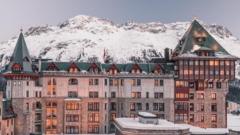The unique challenge in Switzerland's tourism industry lies in balancing between luxury and accessibility, as the spotlight on wealthier guests offers both economic benefits and potential pitfalls for local communities.
Switzerland's Pursuit of Luxury Tourism: A Double-Edged Sword

Switzerland's Pursuit of Luxury Tourism: A Double-Edged Sword
A growing focus on affluent tourists brings prosperity but raises social concerns in Switzerland's alpine resorts.
As global wealth disparities widen and an increasing number of billionaires emerge, Switzerland has set its sights on attracting affluent tourists to its picturesque alpine resorts. Long known for its luxurious hospitality, the country is experiencing a surge in five-star accommodations designed to pamper wealthy guests. Iconic establishments like the Badrutt's Palace Hotel in St. Moritz epitomize the heights of sophistication, providing amenities such as personalized ski butlers and gourmet dining.
Hoteliers are predominantly targeting wealthy travelers from the United States, Gulf states, and emerging markets in China and India. This strategy comes as room rates and services rise. Despite the luxury-focused marketing, Swiss Tourism asserts that catering to high-income individuals is not a detriment to other tourist segments, as high-spending guests significantly contribute to overall tourism revenues.
However, this upscale push raises concerns about local communities being priced out of the market. Towns like St. Moritz and Zermatt face criticism for the impact luxury tourism has on housing affordability for essential service workers. Long commutes for hospitality staff in search of reasonable accommodation have been noted, illustrating the strain that high-end tourism places on small-town life.
The situation is compounded in locations like Wengen, where plans for a new five-star hotel are stirring controversy. Critics argue that the development caters exclusivity while failing to integrate into the local community effectively. Concerns arise about maintaining the unique character of the village as it transitions to high-end luxury.
Yet some locals and tourism officials see promise in the investment and its potential to enrich local economies that have long relied on agriculture and traditional tourism. The complex narrative surrounding luxury tourism in Switzerland illustrates a constant struggle between preserving cultural identity and embracing financial opportunities that accompany wealthier guests.
As the trend towards upscale travel continues, authorities must remain vigilant in ensuring that the charm of Swiss alpine communities isn’t overshadowed by the increasing focus on high-end tourism.




















